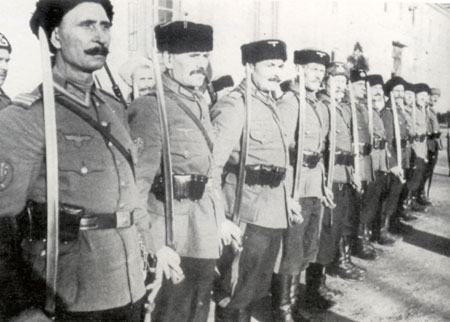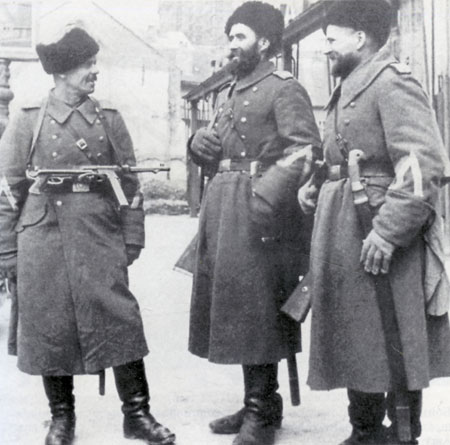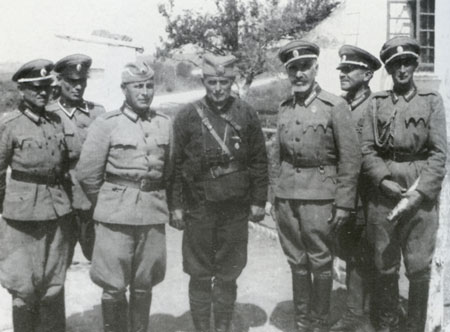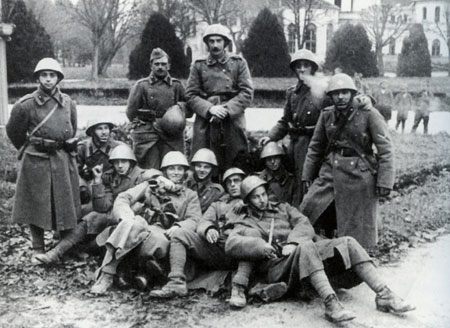After two world wars, the word collaborationism still has an ominous ring to it in nearly all countries regardless of whether they were among the winners or losers. However, whereas collaboration with any aggressor was indeed a shameful stigma to nation states and their people, such as the Vichy France or the Russian Vlasovites, the stateless European nations often had no alternative to “dialog” with Nazi Germany. Finland’s experience in the Second World War is a case in point. However, while still bringing accusations of guilt and crimes against those who unwillingly ended up on the other side of the front, some of the “winners” prefer either to ignore their own collaborationists or even honor them as much as the victims of the war themselves.
Russian post-imperialist ideology depicts the nationalist organizations in the Baltic States, Belarus, Ukraine, and Caucasus, as well as those formed by the Crimean Tatars and Asian peoples as demons from the past. They stand accused of the most shameful crime imaginable — collaborating with Nazi Germany during the Second World War. At the same time, the Kremlin forgets that large numbers of former White Guards joined the same military structures — the SS and Wehrmacht — in the 1940s as did Lithuanian, Kalmyk, and some Ukrainian nationalists.
For Faith, Motherland, and the Führer!
When the topic of the white émigrés’ attitude to Nazi Germany surfaces, the Russian intelligentsia immediately mention Prince Yusupov and General Denikin, who refused to collaborate with the Nazis, and Véra Obolensky, a French resistance movement activist executed by the Nazis. However, they forget to add that there was just a handful of people like Ms. Obolensky and Igor Krivoshein, a White Guard and member of the anti-fascist resistance movement, while thousands of white émigrés served under the Wehrmacht and SS.

General Boris Shteifon, former chief of staff in a White Guard unit commanded by General Bredov (the one who insidiously dislodged the UNR forces from Kyiv), headed the Wehrmacht’s Russian Guard Corps in 1941. Another émigré and one-time Denikin follower, General Skorodumov, set up a military unit of the same caliber. Colonel Buzun, former commander of the famed White Guard Alexeev Regiment, was among his officers.
The Russian Guard Corps was created in 1941 in Yugoslavia to fight against communist partisans commanded by Josip Broz Tito. It consisted exclusively of White Guards — one-time soldiers and officers of Denikin’s army and their descendants. They were joined by 90 former Kornilov’s men and a platoon of the Kutepov company. Colonel Kondratev handed over the banner of the Second Kornilov Strike Regiment to the newly created military unit as nothing short of a sacred object. The corps had a total of 17,000 men. The commanding staff for this auxiliary Wehrmacht unit was trained by the Great Prince Kostantin Konstantinovich First Cadet Corps.

The Russian Guard Corps primarily protected Yugoslav communications against partisan attacks even though they are known to have participated in punitive campaigns against Serbs and despite Russian propaganda now extolling the “brotherhood” felt between Russians and Serbs. The corps fought against Red Army units in 1944 as the Wehrmacht retreated from Greece. On 12 May 1945, it surrendered to the British Army and was not deported to the Soviet zone. The White Guards suddenly declared they were Yugoslav nationals and claimed that they had never held Soviet citizenship, and so it was a mistake to identify them as Russians.
Another White Guard unit was the Russland Division which was formed late in the war and staffed primarily with graduates of several intelligence schools as well as military officers who found themselves abroad. Its commander was former White Guard Colonel Boris Smyslovsky. This unit was remarkable in that it was joined by the Russian successor to the throne from the Romanov dynasty, Prince Vladimir Kirillovich. This was not a spontaneous decision on the part of the prince. He issued an appeal at the outbreak of the war between the USSR and the Third Reich: “In this stern hour, when Germany and nearly all European nations have declared a crusade against Bolshevik communism,… I appeal to all the faithful and loyal sons of our Motherland to contribute, as much as your strength and ability permit, to overthrow the Bolshevik government and liberate our Motherland from the terrible yoke of communism.”
Berlinwarmly welcomed this statement by the last of the Romanov dynasty, but relationships between the White Guard and other Wehrmacht units in which former Soviet citizens served were still far from friendly. Even in the joint battle against communism they constantly engaged in one-upmanship and antagonized each other. General Vlasov demanded from the German command on numerous occasions to have all White Guard units subordinated to him. For their part, former White Guards largely despised Vlasov and the command of the Russian Liberation Army (RLA) as former “Red Army men” and communists. However, there were exceptions, such as General Anton Turkul who was the former commander of the legendary Drozdov Division and later head of the HR department in the RLA. There were plenty of former White Guards among commanding staff of the Vlasov army.

“Fellow countrymen” in the SS
The structure of the Waffen-SS included Russian units like the 29th SS Division RONA, 30th SS Division (also known as the Belorussian Division), and the First Russian SS Brigade Druzhina. These units consisted of former Soviet citizens and had nearly no former White Guards. The SS Variag volunteer regiment was different: just like the Russian Guards Corps, it was staffed almost exclusively with White Guards and their sons, and fought against Serbian and Croatian anti-fascist partisans in Yugoslavia throughout the war. Former White Army soldiers and officers were much better represented in SS Russian Cossack units. These units consisted of men born in the native Cossack lands of the Russian Empire (the Don, Kuban, Terek, and other regions) and started being formed as soon as the Nazis conquered Rostov region, where the Don Cossacks were concentrated.
Influential former leaders of the White Cossack units facilitated the process. For example, former Don Army ataman General Petr Krasnov emphasized: “I ask you to tell all Cossacks that this is not a war against Russia but against communists, Jews, and their henchmen who trade in Russian blood. May the Lord help the German army and Hitler!”
In the summer of 1942, a Cossack military center was set up in the city of Slavuta. All volunteering Cossacks and Red Army POWs who identified themselves as Cossacks were sent there along with White Guard Cossack émigrés, many of whom served as officers in the new units. Seven regiments were formed by August 1942 which were immediately dispatched to fight partisans in Belorussia and Ukraine. The leaders of the Ukrainian Insurgent Army described their punitive campaigns and hard-fought battles in their reports. The Cossacks were a true scourge to Belarusian peasants. German General Max von Scheckendorff, a member of the general staff of the Center army group, wrote in his diary: “The Cossacks are merciless toward the local population.” Later, they distinguished themselves in crushing the Warsaw Uprising and punitive actions against Croatians and Serbs.

The Wehrmacht had 25,000 Cossacks by April 1943. The First Cossack Division commanded by German Major General Helmuth von Pannwitz was formed on 21 April 1943. After prolonged battles against partisans in Ukraine and Belorussia it was moved to Yugoslavia to fight Tito’s partisans. In August 1944, the division was reformatted and became known as the 15th SS Cossack Corps under the command of Gruppenführer von Pannwitz in February 1945. One-time White Guard men — General Krasnov, his brother Semyon, former Wild Division Commander Sultan-Girei Klich, General Andrei Shkuro, and others — put on their new SS uniforms with their double lightning bolt insignia.
It should be noted that even the commanding officers in the corps were not unanimous in their political preferences. Those who advocated joining General Vlasov’s forces were condemned and despised by monarchist Cossacks, who perceived the Vlasovites as former “Red Army men,” while the ideas of “one and indivisible” Russian Empire outraged separatists who were dreaming about an independent Cossack republic. It was the presence of a German commanding officer that kept this motley crew from direct internal conflicts.
The 15th SS Cossack Corps fought largely against the Yugoslav partisans but also conducted the offensive of the 133rd Red Army Rifle Division on the Drava River in December 1944. The corps had up to 35,000 men, including nearly 5,000 Germans who were officers and military specialists. In May 1945, the Cossack units surrendered to the Britons near Lienz in Austria and were handed over to the USSR and eventually faced a tragic fate.
Uncomfortable memories
The regular units of the Wehrmacht, SS, volunteer units, police, and foreign legions had a total of 1,178,000 former Soviet citizens and white émigrés during the Second World War. Russians comprised the largest group (380,000 men), not counting family members. Thirty-six Russians were decorated with the German Iron Cross 2nd degree during the war and 16 of them later received the 1st-degree cross. Huge numbers of Soviet citizens and people who identified themselves as Russians (white émigrés) fought hard together with the Nazis against the Red Army. A number of Russian nationalist organizations view this as sufficient grounds to call the Great Patriotic War the "Second Civil War".
Not all white émigrés supported Nazi Germany, of course. General Denikin refused to cooperate with the Nazis, but in December 1946 he appealed to General Dwight Eisenhower with a request to stop transferring those Russians who had served Nazi Germany to the Soviets. He facilitated in every way their naturalization in the West. From the viewpoint of the Soviet justice system, General Denikin was an undoubted “accomplice to the traitors of the Fatherland.” Russians units within the Wehrmacht and SS on numerous occasions exhibited great-power chauvinism, which made them akin to German Nazis. For example, SS Obersturmbahnführer Vladimir Gil-Rodionov, commander of the First SS Russian Brigade Druzhina killed large numbers of locals during punitive campaigns in Belorussia and had mercy only on those who asked to be spared “in standard Russian.”

The Russian dilemma
What do all these facts have to do with contemporary Russia? Modern Russian leaders were seriously concerned when the Bronze Soldier was relocated in Tallinn. They become outraged when UPA fighters are honored in Ukraine. But at the same time, they fail to notice a memorial plaque honoring SS Russian Cossacks Shkuro, Krasnov, Sultan-Girei Klich, and their Nazi commander, Gruppenführer Helmuth von Pannwitz near the All Saints Church in downtown Moscow.
When the influential Rostov-based businessman Vladimir Melikhov attempted to install a monument to General Petr Krasnov on his property in the village of Yelanskaya in 2007, he sparked a scandal. Hundreds of Don and Kuban Cossacks, the Rostov eparchy clergy and Bishop Michael Donskov of Geneva and the Western European Foreign Russian Orthodox Church came to attend the unveiling ceremony. A week later, Mr. Melikhov was thrown behind bars on charges of tax evasion. He was released only a year later. At the same time, communist Nikolai Kolementsev, a State Duma member, sent a complaint to Russian Prosecutor General Viktor Chaika challenging the legality of a monument to a Nazi henchman. The Prosecutor General’s Office adopted a decision to have the monument removed, but local communities stood up in its defense. The second part of the memorial was unveiled on 25 June 2009. In order to prevent another large gathering of Cossacks, the police cordoned off the area and carried out ID checks.
In August 2010, Mr. Melikhov opened the Museum of Anti-Bolshevik Resistance on his property in Podolsk, a city near Moscow. “When one individual switches over to the enemy, you can call it treason. But what if several thousand do it? That means you need to look for reasons,” he said. Deputy Chairman of the Council of Russian Federation Alexandr Torshin concurs: “The Melikhov museum offers a more objective vision of history, while the times when only one view was correct are, fortunately, in the past.”
Point of View
Igor Rodin, Staff Captain and head of the 2nd section of the Russian General Military Union (RGMU):
“Many leaders of the White Movement who were already abroad at the time were perfectly aware of the predatory nature of Hitler’s advance to the east. However, after living through the atrocities of the civil war and the fall of the Russian Empire, they believed that the greatest evil was the "red scum", which had to be destroyed at any price. One former White Guard officer put it this way – he said that the biological power of Russians was greater than that of Germans. Let them oust the Bolsheviks from Russia, and then we will kick out Germans themselves. It is very hard to many people, especially the youth, to understand this issue, because you need to study a lot and apply your heart and soul to such events as the fall of Russia and the civil war. Only then will you reach an understanding of all [these] things.
“Thus, the Russian General Military Union(RGMU)and other organizations irreversibly sided with Germany, viewing it as a secondary enemy. To RGMU members, the Second World War was nothing less than a Second Civil War. To those who want to understand this and other issues and, the youth above all, I recommend reading at least one work by General Petr Krasnov — From Double-Headed Eagle to Red Flag. I can earnestly assure you that this book can turn any skeptic into a convinced anti-communist. At least, the reader will see with perfect clarity that the starting point of our misfortunes is year 1917.”

